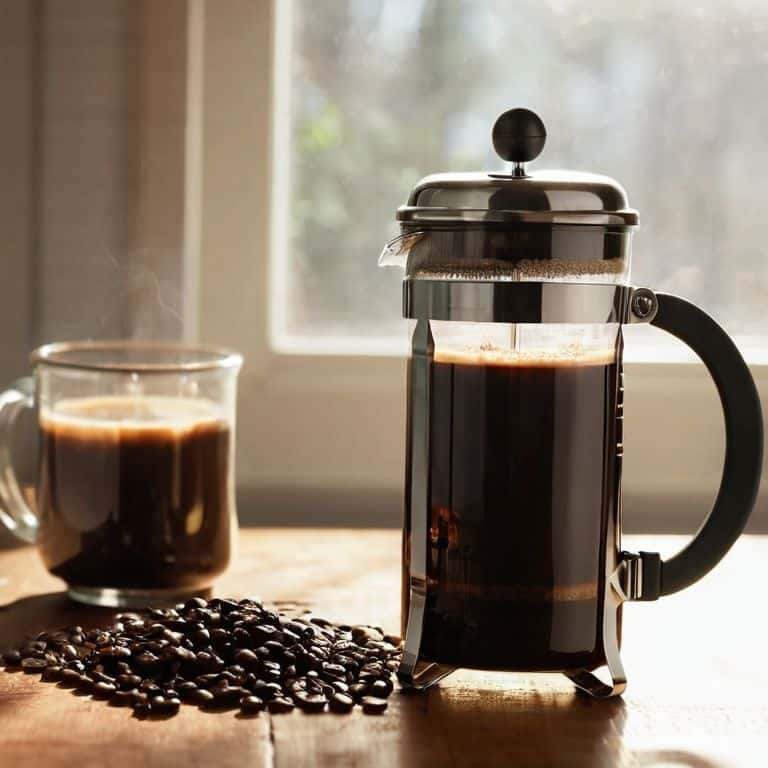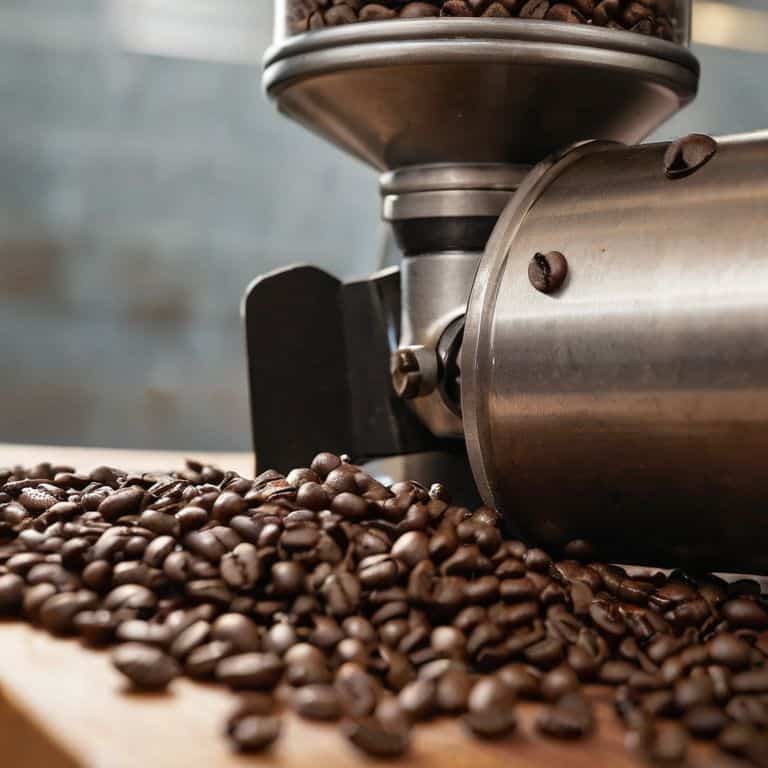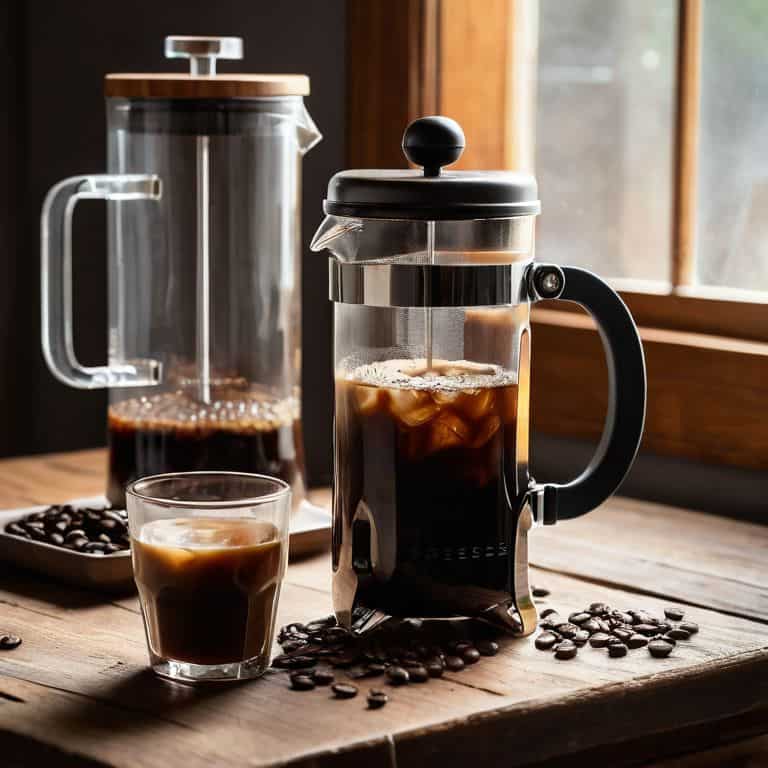I still remember the first time I mastered the art of how to make french press coffee. It was like a revelation – the rich flavors, the velvety texture, and the sense of accomplishment that came with it. But what really got me was the myth that french press coffee is somehow inferior to other brewing methods. I’ve heard people say it’s too bitter, too messy, or just plain too much work. Let me tell you, those people are missing out on a world of flavor and simplicity. As a certified Q Grader and National Barista Champion, I’m here to tell you that brewing the perfect cup is within your reach.
In this article, I’ll share my honest, no-hype advice on how to make french press coffee that will make your taste buds sing. I’ll walk you through the simple, yet crucial steps to extract the full potential of your coffee beans. From the ideal water temperature to the perfect coffee-to-water ratio, I’ll give you the practical tips you need to elevate your brewing game. Whether you’re a coffee newbie or a seasoned enthusiast, this guide is designed to help you achieve cafe-quality results in the comfort of your own home. So, let’s get started on this journey to coffee perfection, and discover the joy of brewing a truly exceptional cup of french press coffee.
Table of Contents
Guide Overview: What You'll Need

Total Time: 5 minutes
Estimated Cost: $20 – $50
Difficulty Level: Easy
Tools Required
- French Press Coffee Maker 1 container, typically 32 ounces
- Kettle for boiling water
- Spoon for measuring coffee
- Scale optional, for precise measurements
Supplies & Materials
- Coffee Beans your preferred brand and roast
- Water fresh, cold water
- Sugar or Creamer optional, for taste
Step-by-Step Instructions
- 1. First, let’s start with the foundation of a great French press: selecting the right coffee beans. I always opt for a high-quality, freshly roasted single-origin coffee that’s been carefully stored to preserve its unique flavor profile. For French press, I recommend a medium to dark roast, as it brings out the rich and full-bodied flavors we’re aiming for.
- 2. Next, we need to prepare our equipment, and that includes the French press itself, a grinder, a scale, and a kettle. I’m quite particular about my grind size, so I use a burr grinder to ensure a consistent grind that’s perfect for French press. You want it to be coarse, but not too coarse, as this will affect the extraction process.
- 3. Now, let’s talk about the coffee-to-water ratio. This is where many people go wrong, but trust me, it’s crucial for achieving that perfect cup. I use a ratio of 1:15 to 1:17, which means for every gram of coffee, I use 15 to 17 grams of water. Measure your coffee and water carefully using a scale, as this precise ratio will make all the difference in the flavor of your coffee.
- 4. With our coffee and water measured, it’s time to heat the water. I aim for a temperature between 93°C and 96°C, as this is the ideal range for extracting the optimal amount of flavors from our coffee. Be careful not to go too high, as this can lead to a bitter taste. I use a thermometer to ensure I’m within the perfect temperature range.
- 5. Now, let’s grind our coffee beans. Remember, we’re aiming for a coarse grind, similar to kosher salt. This will allow for the right amount of extraction during the brewing process. I grind my beans just before brewing to ensure they’re as fresh as possible and to preserve the delicate flavors and oils.
- 6. Next, we add the ground coffee to the French press, making sure to level it out evenly. Then, we pour the heated water over the coffee in a smooth, circular motion, making sure all the grounds are saturated. This is a critical step, as it ensures all the coffee is extracted evenly.
- 7. After pouring the water, we need to steep the coffee. I recommend a steeping time of around 3 to 4 minutes, depending on your personal preference for strength and flavor. The longer it steeps, the stronger the coffee will be. I find that 3 minutes and 30 seconds is my sweet spot for the perfect balance of flavors.
- 8. Finally, it’s time to press the plunger and separate the coffee grounds from the liquid. Do this slowly and carefully to avoid stirring up the grounds and making the coffee cloudy. Pour the coffee into your cup, and you’re ready to enjoy the fruits of your labor. Take a moment to appreciate the rich aroma and flavors you’ve managed to extract from those simple coffee beans.
How to Make French Press Coffee

As I delve deeper into the world of French press coffee, I’ve come to realize that coffee bean selection plays a crucial role in the final product. The type of bean, its origin, and roast level all contribute to the unique flavor profile of your brew. For a French press, I recommend using a darker roast to bring out the bold and rich flavors. When it comes to the french press coffee ratio, a general rule of thumb is to use 1:15 to 1:17 coffee to water. However, this can be adjusted to suit your personal taste preferences.
To take your French press game to the next level, consider experimenting with coffee grind distribution techniques. A consistent grind size is essential for even extraction, and I’ve found that a burr grinder is the best tool for the job. Additionally, steeping time is critical, as it can make or break the perfect cup. Aim for a steeping time of around 4 minutes, but feel free to adjust this to your liking.
In comparison to other brewing methods, such as pour over, French press coffee offers a more immersive and full-bodied experience. By blooming coffee for french press, you can help release the trapped CO2 and allow the coffee to extract more evenly. This simple step can make a significant difference in the final flavor of your brew. Whether you’re a seasoned coffee connoisseur or just starting out, mastering the art of French press coffee is a journey worth taking.
Coffee Bean Selection for Richness
When it comes to selecting coffee beans for French press, I’m obsessed with finding the perfect balance of flavors. For a rich and full-bodied cup, I recommend opting for a single-origin bean with a high altitude and low yield. These beans tend to have a more complex flavor profile, with notes of chocolate and caramel that will shine through in your French press. I personally love using Ethiopian or Colombian beans, as they have a naturally sweet and fruity flavor that pairs perfectly with the immersive brewing method of French press.
By choosing the right beans, you’ll be able to bring out the nuances of flavor that make French press coffee so unique. Trust me, the difference is palpable – and it’s all about finding that perfect harmony of flavors to elevate your brew to the next level.
French Press Coffee Ratio Matters
French Press Coffee Ratio Matters
When it comes to brewing the perfect cup, the ratio of coffee to water is crucial. I’m talking about a golden ratio of 1:15 to 1:17, coffee to water. This means for every gram of coffee, you’ll want to use 15-17 grams of water. Trust me, this ratio makes all the difference in bringing out the unique flavors and oils of your coffee beans.
I’ve experimented with various ratios, and I can confidently say that this range yields the best results. Any lower, and your coffee will be over-extracted; any higher, and it’ll be under-extracted. By hitting this sweet spot, you’ll unlock a world of flavors and aromas that will elevate your French press game.
Elevate Your Brew: 5 Tips for Mastering French Press Coffee

- Use freshly roasted and ground coffee beans to ensure optimal flavor and aroma
- Experiment with the ideal water temperature, between 93°C and 96°C, for the perfect extraction
- Invest in a high-quality French press with a smooth, even plunger to prevent coffee grounds from escaping
- Pay attention to the coffee-to-water ratio, aiming for a balance of 1:15 to 1:17 to bring out the unique characteristics of your chosen coffee beans
- Steep the coffee for precisely 4 minutes to allow the flavors to mature and the body to develop, then press slowly and patiently to avoid stirring up the grounds
Key Takeaways for the Perfect French Press
I’ve found that mastering the French press coffee ratio is crucial, with a general starting point of 1:15 to 1:17 coffee to water, but feel free to experiment to find your ideal balance
Selecting the right coffee beans is vital for richness and flavor, with factors like roast level, processing method, and origin playing a significant role in the final cup’s taste and aroma
Precision is key, so invest in a good coffee scale, thermometer, and burr grinder to ensure consistent results, and don’t be afraid to tweak variables like grind size, water temperature, and steeping time to achieve your perfect cup
The Art of French Press Perfection
The key to unlocking a sublime French press experience lies not just in the ratio of coffee to water, but in the mindful harmony of each element – the grind, the bloom, the pour – a symphony that awakens the senses and stirs the soul.
Julian Vale
The Perfect Cup: A Conclusion
As we’ve journeyed through the world of French press coffee, it’s clear that mastering the ratio of coffee to water is crucial, along with selecting the right coffee beans for richness and flavor. We’ve also explored the importance of using high-quality equipment and paying attention to the little details, like water temperature and grind size. By following these steps and experimenting with different variables, you’ll be well on your way to brewing a cup that rivals your favorite cafe. Remember, it’s all about balance and harmony in the brewing process.
So, as you continue to refine your French press skills, I encourage you to keep pushing the boundaries of what’s possible. Don’t be afraid to try new things and experiment with different roasts. With patience, practice, and a passion for the craft, you’ll be sipping on a perfectly balanced cup in no time. And when that moment arrives, you’ll know that all the effort was worth it – the flavors will dance on your palate, and you’ll be hooked on the pursuit of the perfect cup.
Frequently Asked Questions
What's the ideal water temperature for French press coffee to bring out the best flavors?
For me, the sweet spot is between 93°C and 96°C. Any higher, and you’ll extract too much; any lower, and you’ll miss out on those beautiful, nuanced flavors. I’m talking about a temperature that coaxes out the best in your beans, without overpowering them. Trust me, it makes all the difference in your French press game.
How do I know if I'm using the right grind size for my French press?
Ah, grind size – the secret sauce! For French press, you’re aiming for a coarse grind, similar to kosher salt. If it’s too fine, you’ll end up with over-extracted bitterness. Too coarse, and it’s under-extracted. I like to test my grind by feeling it between my fingers – it should have a smooth, even texture. Experiment and taste, my friend, until you find that sweet spot!
Can I use any type of coffee bean for French press or are there specific ones that work better?
Not all beans are created equal for French press. I swear by high-quality, medium to dark roasts with notes of chocolate and caramel. Look for beans with a coarse texture, like Sumatran or Brazilian, they’ll give you that rich, full-bodied flavor. Avoid super light roasts, they can be too bright and acidic, throwing off the balance. Trust me, the right bean makes all the difference.



